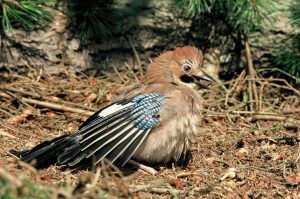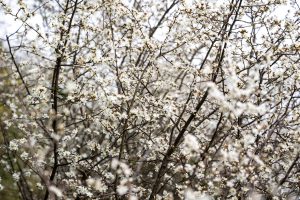The Ideal Combination of Bird Foods & Feeders
One of the questions we’re often asked at Vine House Farm is:
In some ways, it’s a bit of tricky question and there probably isn’t a single best answer, plus at certain times of the year, the combination would change – e.g. including live mealworms in a special feeder during the breeding and fledgeling season. However, what we certainly can do is detail the main factors to consider and, from this, come up with an outline list. So let’s start with those main factors to consider…
Birds that feed in gardens can roughly be split between softbills – which is not a scientific term but is the one widely used to very broadly describe birds which eat soft foods such as insects and fruit – and those which can crack open seeds.
So the Robin and Blackbird are softbills, whereas all the finches aren’t and, unlike the softbills, can crack open a seed in their bill. However, it isn’t quite a simple as that because Blue Tits and Great Tits are technically softbills but can crack open a large seed such as black sunflower if they hold it in their feet and chip away at it – which they’re very good at doing. And to make it a tad more complicated, many softbill birds – the Robin being a good example – will eat very small seeds with the husk on as they’re able to digest this. So the main points here are:
Many softbill species are ground feeders. That isn’t to say that those that are won’t feed in trees and hedges and, as a good example, Blackbirds will readily feed on Hawthorn berries in hedges. However, their preference is to feed on the ground and a hanging feeder is normally going to be out of the question for them. That said, hanging feeders which have round perches which, effectively act as a platform, will be used by some species and particularly the Robin.
All other garden birds such as tits and finches are typically comfortable on hanging feeders, though Chaffinches struggle to balance on straight perches and much prefer the round platform type.
Most of the foods we buy and put out for the birds in our garden are of course not ones that they’d naturally find in the wild. Niger seed is a good example, as this tiny seed actually comes from a plant called the Ramtil plant which grows in naturally in Ethiopia. But this fact hasn’t stopped it becoming a favourite with Goldfinches and Siskins, and indeed the ready supply of it in some gardens is believed to have helped the Goldfinch population increase in recent years. Niger is rich in fat and protein and no doubt birds have a way of sensing its food value to them. Long-tailed Tits love suet blocks, Tree Sparrows love red millet, Great Spotted Woodpeckers love peanuts and suet pellets in a cage feeder, but virtually all garden birds love sunflower hearts. So many birds have food preferences but safe to say that, if you only put out one food, then sunflower hearts would be the safest bet to go for.
The above are not all of the factors and the ones we’ve covered we’ve skimmed over a bit, but you’ll be getting the idea anyway. So our ideal combination of foods and feeders for an average sized suburban garden would be this:
This list isn’t, of course, definitive and there will be other combinations which will work, but what it does represent is something which takes account of the main factors outlined above, and therefore will give you every chance of attracting the largest number of different bird species to your garden.
"What is the best combination of different foods and feeders in order to attract the most number of bird species to a garden?"
In some ways, it’s a bit of tricky question and there probably isn’t a single best answer, plus at certain times of the year, the combination would change – e.g. including live mealworms in a special feeder during the breeding and fledgeling season. However, what we certainly can do is detail the main factors to consider and, from this, come up with an outline list. So let’s start with those main factors to consider…
Softbill or Seed Cracker
Birds that feed in gardens can roughly be split between softbills – which is not a scientific term but is the one widely used to very broadly describe birds which eat soft foods such as insects and fruit – and those which can crack open seeds.
So the Robin and Blackbird are softbills, whereas all the finches aren’t and, unlike the softbills, can crack open a seed in their bill. However, it isn’t quite a simple as that because Blue Tits and Great Tits are technically softbills but can crack open a large seed such as black sunflower if they hold it in their feet and chip away at it – which they’re very good at doing. And to make it a tad more complicated, many softbill birds – the Robin being a good example – will eat very small seeds with the husk on as they’re able to digest this. So the main points here are:
- Softbill birds such as the Blackbird, Robin, Dunnock and Song Thrush cannot eat large seeds which have their husk on – e.g. black sunflower
- Most other garden birds can eat all sizes of seed, with finches cracking the seed open in their bill and tits holding the seed in their feet to chip away at the husk
Perching and Non-Perching
Many softbill species are ground feeders. That isn’t to say that those that are won’t feed in trees and hedges and, as a good example, Blackbirds will readily feed on Hawthorn berries in hedges. However, their preference is to feed on the ground and a hanging feeder is normally going to be out of the question for them. That said, hanging feeders which have round perches which, effectively act as a platform, will be used by some species and particularly the Robin.
All other garden birds such as tits and finches are typically comfortable on hanging feeders, though Chaffinches struggle to balance on straight perches and much prefer the round platform type.
Food Preference and Nutrition Levels
Most of the foods we buy and put out for the birds in our garden are of course not ones that they’d naturally find in the wild. Niger seed is a good example, as this tiny seed actually comes from a plant called the Ramtil plant which grows in naturally in Ethiopia. But this fact hasn’t stopped it becoming a favourite with Goldfinches and Siskins, and indeed the ready supply of it in some gardens is believed to have helped the Goldfinch population increase in recent years. Niger is rich in fat and protein and no doubt birds have a way of sensing its food value to them. Long-tailed Tits love suet blocks, Tree Sparrows love red millet, Great Spotted Woodpeckers love peanuts and suet pellets in a cage feeder, but virtually all garden birds love sunflower hearts. So many birds have food preferences but safe to say that, if you only put out one food, then sunflower hearts would be the safest bet to go for.
Best Bird Feeder & Bird Food Combinations - Our List
The above are not all of the factors and the ones we’ve covered we’ve skimmed over a bit, but you’ll be getting the idea anyway. So our ideal combination of foods and feeders for an average sized suburban garden would be this:
- Hanging feeder with round perches such as the Onyx (or you can add Perch Rings to a Droll Yankee feeder with straight perches) and filled with Sunflower Hearts or Black Sunflower seed.
- A second hanging feeder, and again with round perches, with a high-quality husk-free seed mix such as VHF Ultimate Energy with Suet, or VHF Premium High Energy Mix.
- A hanging Niger Seed Feeder.
- A hanging Mesh Feeder and filled with either Suet Pellets, Peanuts, or a combination of both.
- A hanging Suet block or Suet Ball Feeder.
- Importantly, a Ground Feeding Tray or Compact Ground Feeder and filled with any husk-free mix, or Sunflower Hearts, or Suet Pellets, or Chopped Peanuts (never whole ones) or any combination of these foods. Note that as this sort of feeder will be used by the ground feeding softbill species such as Blackbird and Robin, larger seeds with their husk on won’t be suitable.
- And certainly, for the breeding and fledging season, a Caged Live Food Feeder filled with Live Mealworms.
This list isn’t, of course, definitive and there will be other combinations which will work, but what it does represent is something which takes account of the main factors outlined above, and therefore will give you every chance of attracting the largest number of different bird species to your garden.


